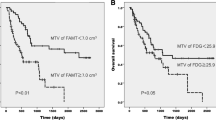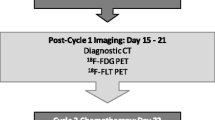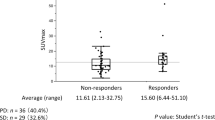Abstract
Purpose
The aim of this study is to investigate the role of standard uptake values (SUVs) and metabolic tumor volume (MTV) in [18F]fluorodeoxyglucose positron emission tomography/computed tomography (FDG PET/CT) to predict the short-term outcome of chemoradiotherapy (CRT) in patients with advanced non-small cell lung cancer (NSCLC).
Methods
A total of 37 patients were included in the prospective study. All patients were evaluated by FDG PET before and following 40 Gy radiotherapy (RT) with a concurrent cisplatin-based chemotherapy regimen. Semiquantitative assessment was used to determine maximum and mean SUVs (SUVmax/SUVmean) and metabolic tumor volume (MTV). Short-term outcome using the treatment response evaluation was assessed according to the Response Evaluation Criteria in Solid Tumors. The receiver-operating characteristic (ROC) curve analysis was used to determine the diagnostic accuracy of 18F-FDG PET in identifying responders.
Results
Changes in SUVmax, SUVmean, and MTV were significantly more pronounced in responders than in nonresponders (p = 0.002, 0.002, 0.000). The thresholds of SUVmax, SUVmean, and MTV changes defined by ROC curve analysis were 37.2, 41.7, and 29.7%, respectively. The sensitivity, specificity, and accuracy of SUVmax change for predicting tumor response were 83.3, 84.6, and 84.9%, respectively. The sensitivity, specificity, and accuracy of SUVmean change for predicting tumor response were 79.2, 100, and 88.8%, respectively. The sensitivity, specificity, and accuracy of MTV change for predicting tumor response were 91.7, 84.6, and 92.3%, respectively.
Conclusion
SUV and MTV changes from two serial 18F-FDG PET/CT scans, before and after initial CRT, allow prediction of the treatment response in advanced NSCLC.



Similar content being viewed by others
References
Manegold C, Thatcher N. Survival improvement in thoracic cancer: progress from the last decade and beyond. Lung Cancer 2007;57:S3–5.
Strauss LT, Herndon J, Chang J, Parker WY, Levy DA, Bowens SB, et al. Abortion surveillance–United States, 2001. MMWR Surveill Summ 2004;53(9):1–32.
Jin B, Huang AM, Zhong RB, Han BH. The value of tumor markers in evaluating chemotherapy response and prognosis in Chinese patients with advanced non-small cell lung cancer. Chemotherapy 2010;56(6):417–23.
Aggarwal C, Somaiah N, Simon GR. Biomarkers with predictive and prognostic function in non-small cell lung cancer: ready for prime time? J Natl Compr Canc Netw 2010;8(7):822–32.
Wang J, Yi Y, Li B, Wang Z, Sun H, Zhang P, et al. CYFRA21-1 can predict the sensitivity to chemoradiotherapy of non-small-cell lung carcinoma. Biomarkers 2010;15(7):594–601.
Lee DH, Kim SK, Lee HY, Lee SY, Park SH, Kim HY, et al. Early prediction of response to first-line therapy using integrated 18F-FDG PET/CT for patients with advanced/metastatic non-small cell lung cancer. J Thorac Oncol 2009;4(7):816–21.
Nahmias C, Hanna WT, Wahl LM, Long MH, Hubner KF, Townsend DW. Time course of early response to chemotherapy in non-small cell lung cancer patients with 18F-FDG PET/CT. J Nucl Med 2007;48(5):744–51.
Ciernik IF, Dizendorf E, Baumert BG, Reiner B, Burger C, Davis JB, et al. Radiation treatment planning with an integrated positron emission and computer tomography (PET/CT): a feasibility study. Int J Radiat Oncol Biol Phys 2003;57:853–63.
Therasse P, Arbuck SG, Eisenhauer EA, Wanders J, Kaplan RS, Rubinstein L, et al. New guidelines to evaluate the response to treatment in solid tumors. European Organization for Research and Treatment of Cancer, National Cancer Institute of the United States, National Cancer Institute of Canada. J Natl Cancer Inst 2000;92:205–16.
Querellou S, Valette F, Bodet-Milin C, Oudoux A, Carlier T, Harousseau JL, et al. FDG-PET/CT predicts outcome in patients with aggressive non-Hodgkin’s lymphoma and Hodgkin’s disease. Ann Hematol 2006;85(11):759–67.
Lin C, Itti E, Haioun C, Petegnief Y, Luciani A, Dupuis J, et al. Early 18F-FDG PET for prediction of prognosis in patients with diffuse large B-cell lymphoma: SUV-based assessment versus visual analysis. J Nucl Med 2007;48(10):1626–32.
Schwarz-Dose J, Untch M, Tiling R, Sassen S, Mahner S, Kahlert S, et al. Monitoring primary systemic therapy of large and locally advanced breast cancer by using sequential positron emission tomography imaging with [18F]fluorodeoxyglucose. J Clin Oncol 2009;27(4):535–41.
Wieder HA, Beer AJ, Lordick F, Ott K, Fischer M, Rummeny EJ, et al. Comparison of changes in tumor metabolic activity and tumor size during chemotherapy of adenocarcinomas of the esophagogastric junction. J Nucl Med 2005;46(2):2029–34.
Ceresoli GL, Chiti A, Zucali PA, Rodari M, Lutman RF, Salamina S, et al. Early response evaluation in malignant pleural mesothelioma by positron emission tomography with [18F]fluorodeoxyglucose. J Clin Oncol 2006;24(28):4587–93.
Francis RJ, Byrne MJ, van der Schaaf AA, Boucek JA, Nowak AK, Phillips M, et al. Early prediction of response to chemotherapy and survival in malignant pleural mesothelioma using a novel semiautomated 3-dimensional volume-based analysis of serial 18F-FDG PET scans. J Nucl Med 2007;48(9):1449–58.
Hutchings M, Loft A, Hansen M, Pedersen LM, Buhl T, Jurlander J, et al. FDG-PET after two cycles of chemotherapy predicts treatment failure and progression-free survival in Hodgkin lymphoma. Blood 2006;107:52–9.
Gallamini A, Rigacci L, Merli F, Nassi L, Bosi A, Capodanno I, et al. The predictive value of positron emission tomography scanning performed after two courses of standard therapy on treatment outcome in advanced stage Hodgkin’s disease. Haematologica 2006;91:475–81.
Rousseau C, Devillers A, Sagan C, Ferrer L, Bridji B, Campion L, et al. Monitoring of early response to neoadjuvant chemotherapy in stage II and III breast cancer by [18F]fluorodeoxyglucose positron emission tomography. J Clin Oncol 2006;24(34):5366–72.
Dose Schwarz J, Bader M, Jenicke L, Hemminger G, Jänicke F, Avril N. Early prediction of response to chemotherapy in metastatic breast cancer using sequential 18F-FDG PET. J Nucl Med 2005;46(7):1144–50.
Ott K, Weber WA, Lordick F, Becker K, Busch R, Herrmann K, et al. Metabolic imaging predicts response, survival, and recurrence in adenocarcinomas of the esophagogastric junction. J Clin Oncol 2006;24(29):4692–8.
Gillham CM, Lucey JA, Keogan M, Duffy GJ, Malik V, Raouf AA, et al. (18)FDG uptake during induction chemoradiation for oesophageal cancer fails to predict histomorphological tumour response. Br J Cancer 2006;95(9):1174–9.
Cerfolio RJ, Bryant AS, Winokur TS, Ohja B, Bartolucci AA. Repeat FDG-PET after neoadjuvant therapy is a predictor of pathologic response in patients with non-small cell lung cancer. Ann Thorac Surg 2004;78(6):1903–9.
Pöttgen C, Levegrün S, Theegarten D, Marnitz S, Grehl S, Pink R, et al. Value of 18F-fluoro-2-deoxy-D-glucose-positron emission tomography/computed tomography in non-small-cell lung cancer for prediction of pathologic response and times to relapse after neoadjuvant chemoradiotherapy. Clin Cancer Res 2006;12(1):97–106.
Weber WA, Ziegler SI, Thödtmann R, Hanauske AR, Schwaiger M. Reproducibility of metabolic measurements in malignant tumors using FDG PET. J Nucl Med 1999;40:1771–7.
Thie JA. Understanding the standardized uptake value, its methods, and implications for usage. J Nucl Med 2004;45:1431–4.
Weber WA. Assessing tumor response to therapy. J Nucl Med 2009;50 Suppl 1:1S–10.
Weber WA. Use of PET for monitoring cancer therapy and for predicting outcome. J Nucl Med 2005;46:983–95.
Acknowledgment
We thank the PET/CT staff and the technologists at our institute for their excellent support. All authors have read and approved the manuscript.
Conflicts of interest
None.
Author information
Authors and Affiliations
Corresponding author
Electronic supplementary material
Below is the link to the electronic supplementary material.
ESM 1
(DOC 271 kb)
Rights and permissions
About this article
Cite this article
Huang, W., Zhou, T., Ma, L. et al. Standard uptake value and metabolic tumor volume of 18F-FDG PET/CT predict short-term outcome early in the course of chemoradiotherapy in advanced non-small cell lung cancer. Eur J Nucl Med Mol Imaging 38, 1628–1635 (2011). https://doi.org/10.1007/s00259-011-1838-5
Received:
Accepted:
Published:
Issue Date:
DOI: https://doi.org/10.1007/s00259-011-1838-5




